Here’s the truth: The best webinars aren’t always live. They just look and feel like it. The secret is the simulive webinar: a format that delivers all the energy of a live event without the stress, tech hiccups, or burnout.
After hosting 300+ webinars and helping 50+ companies in SaaS, education, and training, I’ve seen what makes this format work and the mistakes that can ruin it.
In this blog, you’ll learn:
- What are simulive webinars, and how do they differ from automated or hybrid events?
- Step-by-step guidance to create your own.
- The benefits, challenges, and best practices pros swear by.
Once you are through, you’ll know how to run webinars that wow audiences while saving your sanity.
Let’s get started.
What Is a Simulive Webinar?
A simulive (or simulated live webinar) is a pre-recorded presentation that plays at a scheduled time but feels like a live event.
Attendees register, join at the set hour, and experience the content in real time without the ability to pause or skip ahead.
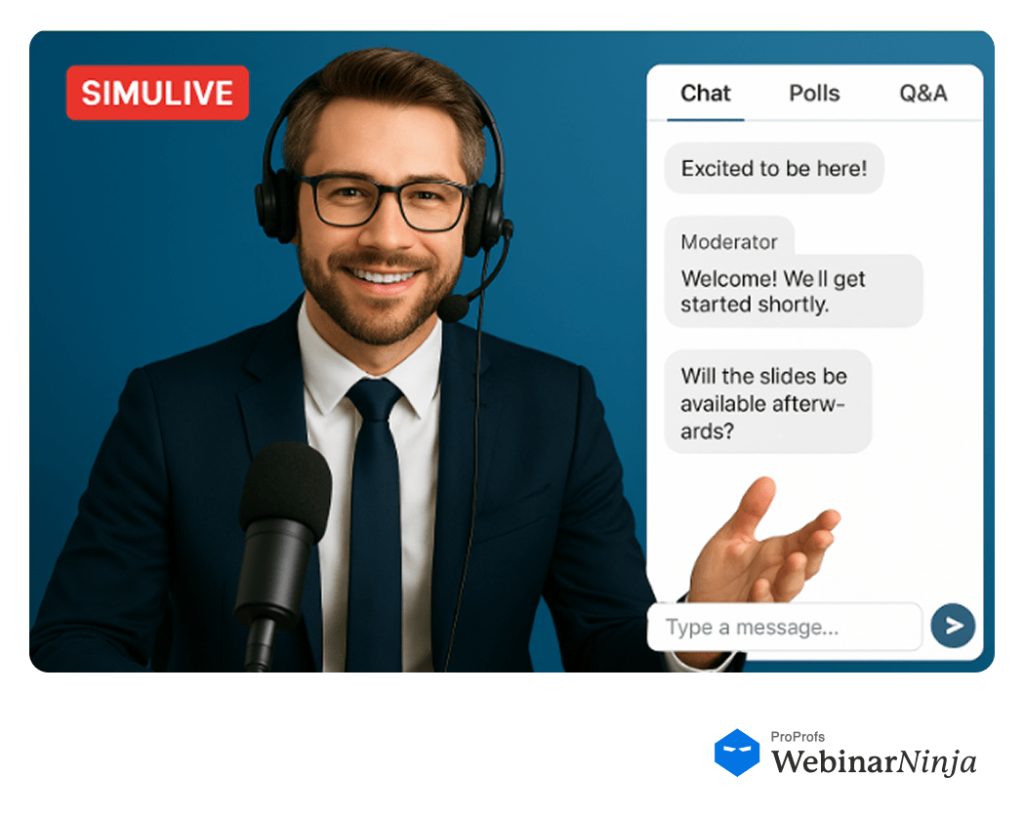
What makes it effective is the live engagement layer: hosts or moderators can answer questions in chat, launch polls, and run a Q&A while the recording plays.
The essential ingredients are simple: polished pre-recorded webinar content, a set schedule to drive attendance, and real-time interaction to keep it engaging.
When I first tried a simulated webinar, I worried it would feel “fake.” Instead, I found the opposite: by freeing myself from presenting, I could focus entirely on my audience. One attendee even told me, “That was the smoothest webinar I’ve ever joined.”
Sounds good? But here’s a question every other person might have.
Is a Simulive Webinar Just a Fake Webinar?
I hear this question most often: “Aren’t simulative webinars just fake webinars?” The short answer is NO.
A simulive webinar is not about tricking people; it’s about delivering a recorded webinar with live Q&A and chat, so your audience still feels seen and supported.
Here’s how I frame it from experience: I tell attendees up front, “This presentation is pre-recorded to give you the smoothest experience, but I’ll be here live in chat to answer your questions.”
That simple disclosure builds trust while keeping the benefits.
What’s truly “fake” is using automated webinar tools with phony chats or pretending people are online when they’re not. I strongly advise against that. Trust matters more than tactics.
If you position your Simulive webinar as a professional way to balance quality and engagement, it becomes a credible alternative to traditional live webinars.
Now that we’ve defined a simulative webinar and addressed whether it’s “fake,” let’s move on to a critical comparison. Many people also hear terms like automated webinars and hybrid webinars and wonder how they differ.
Let’s compare these side by side to get a better idea.
Simulive Webinar vs Automated Webinars vs Hybrid Webinars
Choosing the right type of webinar depends on your goals — whether you want to scale lead generation, deliver evergreen webinar sessions, or create a live webinar alternative with high engagement. Here’s a detailed comparison:
| Aspect | Simulive Webinar | Automated Webinar | Hybrid Webinar |
|---|---|---|---|
| Definition | Pre-recorded presentation broadcast at a scheduled time with live chat, polls, and Q&A. | Pre-recorded webinar that runs automatically, often as an on-demand evergreen session with little or no host presence. | A mix of pre-recorded and live segments, e.g., a keynote replay followed by a live panel or Q&A. |
| Core Content | Pre-recorded video of a talk, demo, or training. | Pre-recorded video that plays unattended, sometimes with pre-set interactions. | Combination: some parts pre-recorded, others fully live. |
| Schedule & Access | Fixed times; feels like a live event. | Can be scheduled or on-demand; popular for evergreen webinar sessions. | Scheduled like a live event, with both recorded and live parts. |
| Engagement | High; live chat, polls, and often a live Q&A. | Moderate; polls or surveys may be pre-set; chats are often answered later. | Very high; real-time interaction in live portions plus polls in recorded parts. |
| Host Involvement | Moderate; no live speaking, but active in chat. | Low; the system delivers the webinar; hosts engage only after. | High; presenters must be available for live segments. |
| Best For | Reducing public speaking anxiety, repeatable demos, compliance training, marketing events needing engagement. | Scaling marketing funnels, automated product education, and evergreen webinar sessions for lead generation. | Launches, town halls, virtual event engagement, or training where spontaneity matters. |
| Pros | Balanced; polished delivery plus live interaction. | Ultra-scalable, flexible, strong for recorded webinars with Q&A later. | Combines the energy of live with safety of recorded content. |
| Cons | Limited spontaneity, still needs moderation. | Can feel impersonal; lower engagement if not designed well. | More resource-heavy, live risks remain. |
| Perceived Liveness | High — most attendees believe it’s live. | Medium — attendees often realize it’s pre-recorded. | Very high — always has live elements. |
Now that we’ve compared the types of webinars, let’s dig into why people like you and me actually search for simulive webinars in the first place.
But before that, here’s a quick video that would clear all your doubts related to automated webinars:
Why People Search for Simulated Webinars
When I first stumbled across the term simulated live webinar, I was burned out from running live sessions back-to-back.
I remember thinking, “I need a live webinar alternative that doesn’t drain me but still keeps people engaged.” That’s exactly what led me, and many others, to explore simulive webinars.
Here are the main reasons I see people searching for them:
- To ease presentation stress. If you’re like me, the thought of repeating the same demo four times a week feels exhausting. A simulive webinar lets you record your best take once and reuse it while staying active in chat. In fact, a webinar simulated live can deliver the same energy as a real-time session while freeing you to focus on your audience. One client of mine said, “It’s the first time I’ve actually enjoyed a webinar because I wasn’t juggling slides and questions.”
- To reach global audiences. I once had attendees from three continents. Scheduling live events for all time zones was a nightmare. With simulive, I simply scheduled multiple replays, and suddenly I looked “available everywhere.”
- To boost engagement compared to on-demand recordings. On-demand feels passive. Simulive forces attendance at a set time, and because I was present in chat, people stayed until the end. That’s when conversions happened.
- To find the right platform. Honestly, the turning point for me was discovering the best simulated live webinar software that supported live chat, polls, and automated scheduling. Before that, I was hacking together solutions that always broke at the worst time.
Now that we know why people search for simulive webinars, let’s look at how to actually create one.
How Do I Create a Simulive Webinar?
Creating a simulive (or simulated live) webinar varies depending on the platform you use. The steps usually involve creating the event, adding a pre-recorded video, scheduling the time, and configuring engagement tools like chat and polls.
To make this concrete, I’ll walk you through how I do it with WebinarNinja, one of the most reliable platforms for hosting simulive sessions.
1. Create a New Webinar
From My Webinars, click the blue Create New Webinar button.
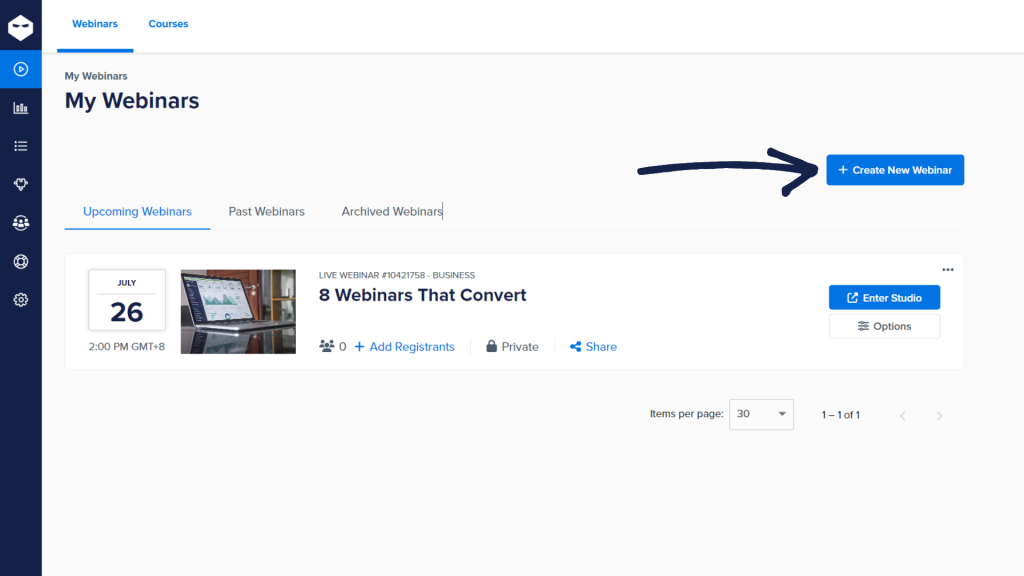
2. Select Automated or Hybrid
Choose Automated for a fully scheduled simulive session, or Hybrid if you want to mix recorded content with a live Q&A.

3. Enter Webinar Details
Add a title, description, date, time, and duration. For evergreen webinar sessions, configure recurring schedules (daily, weekly, or monthly).
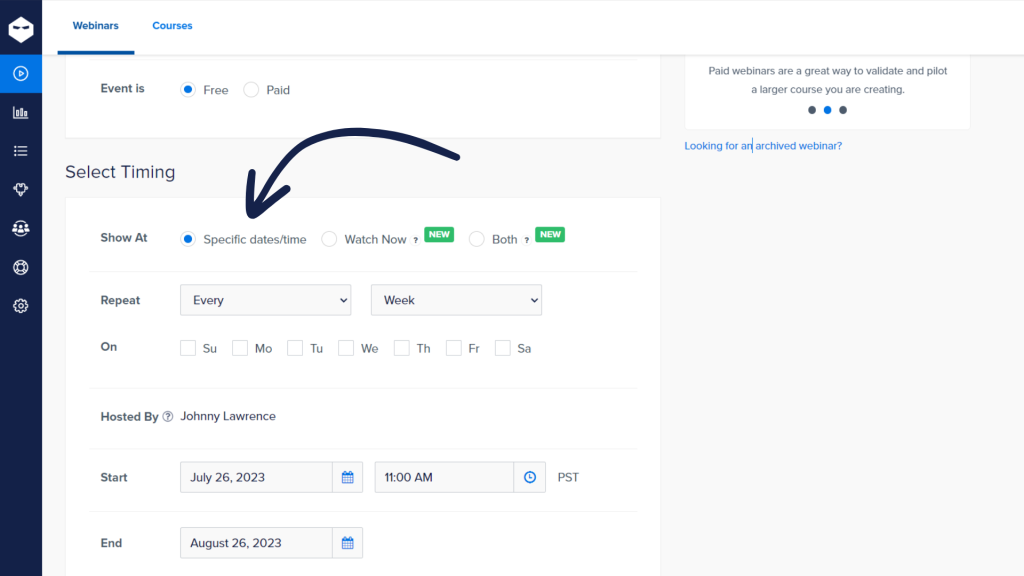
4. Add Video Files
Upload a video, select one from your Media Library, or link to a YouTube video. You can even set start and end times and decide if you want to enable player controls for registrants during playback.
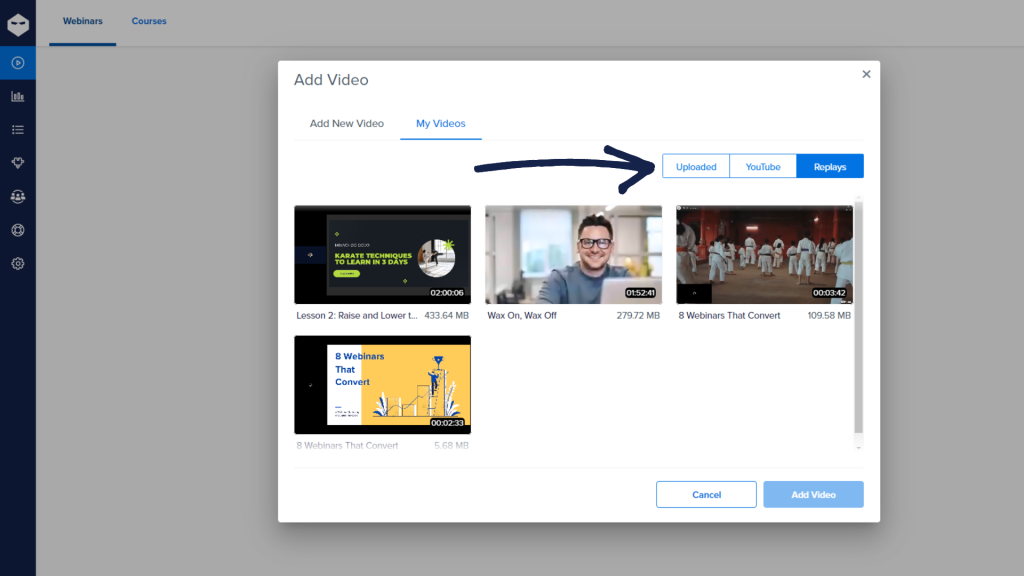
5. Finalize & Create
Click Create Webinar, and your Simulive session is ready for registration.
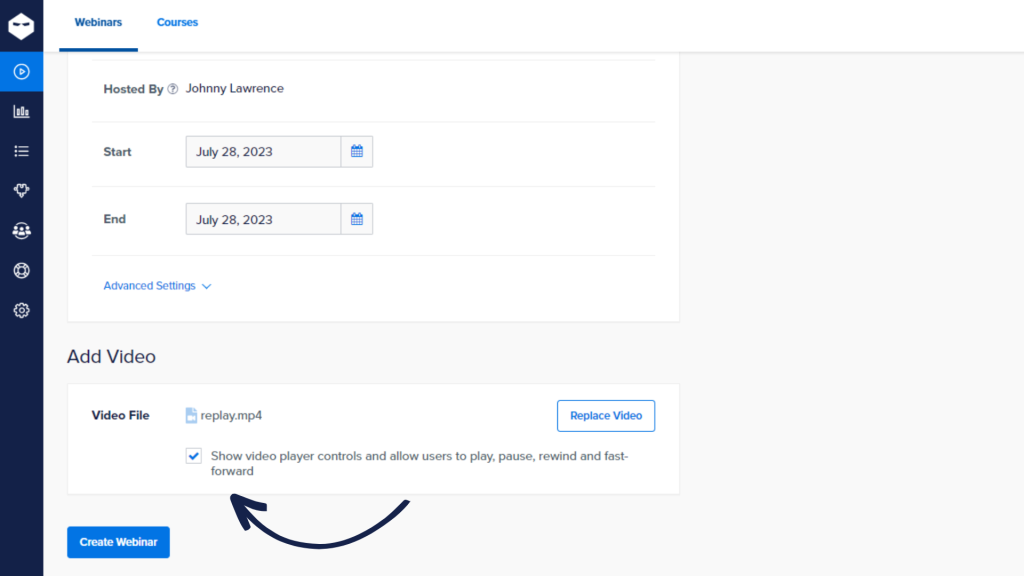
From experience, the most important part is not just uploading the video, it’s designing the engagement layer. I always prepare my chat messages and polls in advance, so when the webinar runs, I can focus 100% on my attendees.
And don’t worry, if you want conversions, here’s a perfect video that can help:
Now that you know how to create a simulive webinar, let’s talk about why they’re so effective.
Key Benefits of Simulive Webinars
I’ve been running webinars for years, and I can confidently say that Simulive has been a reward for my efforts. The benefits go far beyond convenience; they transform how you deliver, engage, and scale your sessions.
1. Reduced Stress & Improved Presenter Confidence
One of the biggest reasons I turned to Simulive webinars was public speaking anxiety. Before going live, I’d feel my stomach knot up, and one small glitch, like a slide not loading, would throw me completely. Recording in advance changed that.
- I could take my time, re-record if needed, and polish the final version.
- On the day of the webinar, I only needed to log in, greet attendees, and handle questions in the chat.
As one attendee once told me, “You looked so calm and focused compared to other webinars I’ve joined.” The truth is, I wasn’t “presenting” at all; I was fully present for them.
2. Consistency & Higher Quality Across Sessions
Live sessions are unpredictable. Sometimes you’re on fire, other times you forget a key example. With Simulive, your audience gets the best version of your talk every single time.
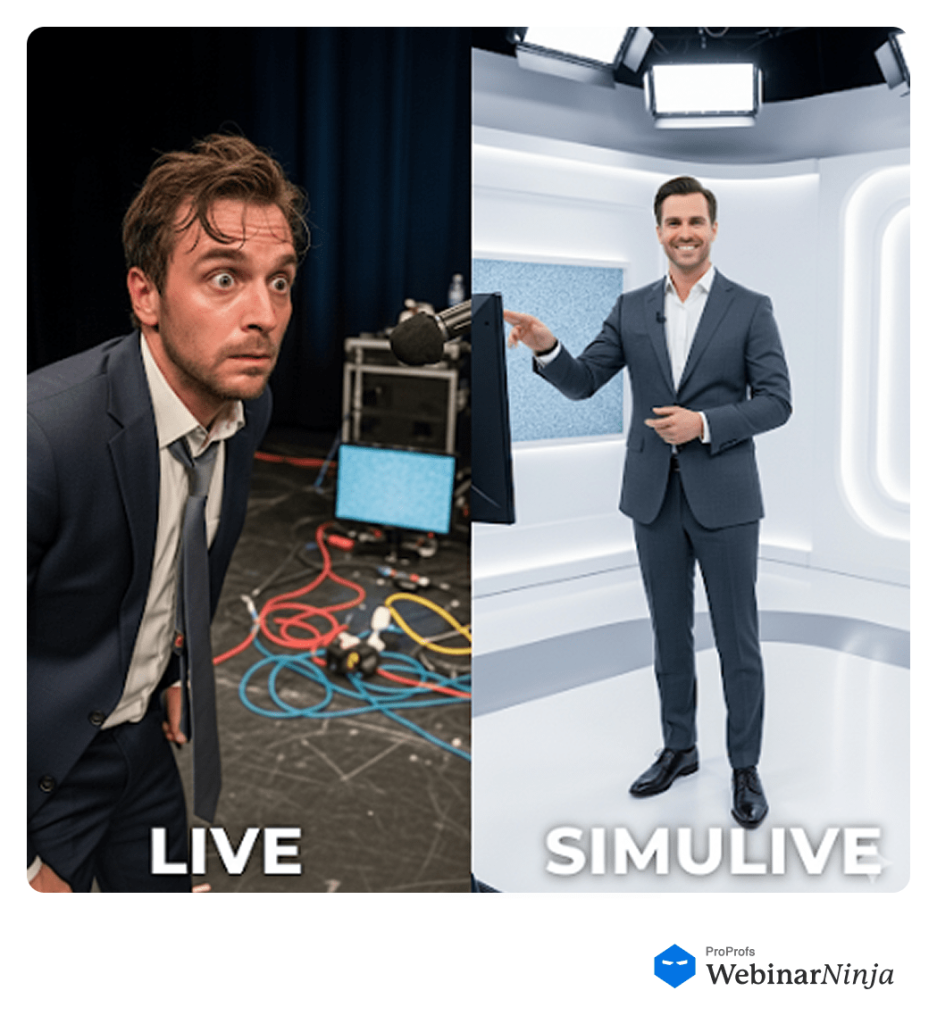
I once had to deliver the same product demo webinar five times in two weeks. By the fifth run, I was exhausted, and it showed. When I switched to Simulive:
- Every attendee, no matter when they joined, saw the exact same polished delivery.
- My brand message stayed consistent and professional.
This matters even more in industries like finance or compliance, where accuracy is non-negotiable.
3. Real-Time Engagement Without Presentation Pressure
One of the most powerful aspects of Simulive is separating the presentation from the interaction. In a live webinar, I’d be juggling slides, questions, and chat all at once. With Simulive:
- The video runs smoothly on its own.
- I’m in the chat answering questions, welcoming people, and even sharing bonus resources.
I’ll never forget a comment I got during a simulive session: “I don’t know how you present and answer so fast at the same time!” That’s the beauty of it. Simulive makes you look superhuman while actually making your job easier.
4. Flexible Scheduling to Reach Global Audiences
When attendees are spread across time zones, live webinars force you to prioritize one group. With Simulive, I can schedule multiple broadcasts for different regions without doing extra work.
- Morning for Asia-Pacific, afternoon for Europe, evening for the US. Same polished content, delivered “live” at times that suit everyone.
This flexibility boosted my attendance rate by nearly 40% compared to running just one live session.
5. Evergreen Content That Scales With Your Business
The first time I realized the true power of Simulive was when I turned a single demo into an evergreen webinar session. That one recording kept generating leads for months.
- I scheduled it to replay weekly.
- People kept registering, attending, and asking questions in chat.
- My calendar stayed free while my funnel stayed full.
It’s like cloning your best presentation and having it work for you 24/7.
6. Compliance & Control in Sensitive Industries
In sectors where words matter, like healthcare, law, or finance, going off-script in a live event can be risky. I worked with a client who needed legal review before any presentation went public. With Simulive:
- We recorded, reviewed, and approved the content.
- Nothing went live until it was signed off.
The result was peace of mind for them and a flawless experience for their attendees.
Okay, now that we know the benefits, let’s get real about the challenges that come with simulive webinars.
Challenges & Pain Points of Simulive Webinars
Even though simulive webinars are powerful, they’re not perfect. I’ve faced several hurdles myself, and I’ve also heard the same frustrations echoed by other hosts. The good news is that once you recognize these challenges, you can plan around them.
Here’s how to tackle some of the common ones:
1. The Authenticity Dilemma: Is It Really Honest?
The first question I faced was, “Will people feel cheated if they find out this isn’t truly live?”
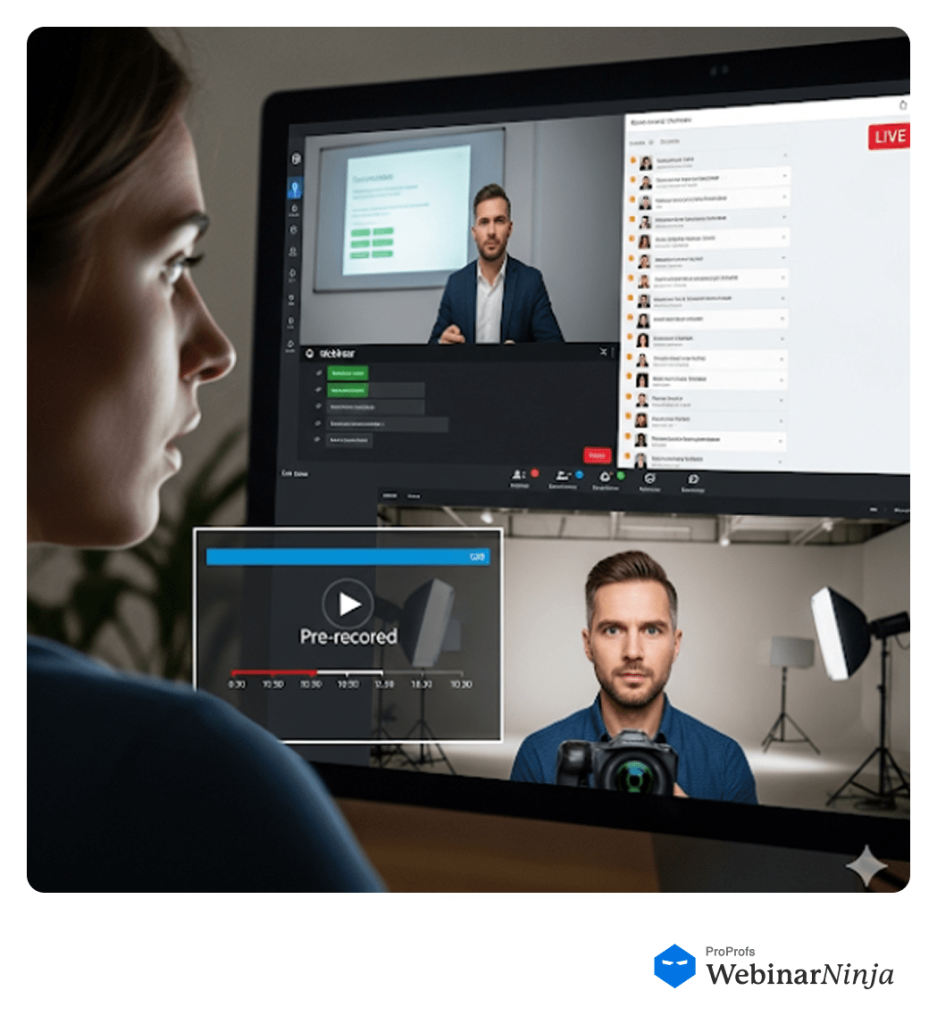
Transparency is critical here.
I now always tell attendees, “The presentation is pre-recorded to give you the best version, but I’ll be here live in the chat.”
That framing keeps trust intact while still delivering the benefits. The pain point isn’t the format itself; it’s how you position it.
2. Engagement Drop-Off Without Smart Interaction
If you just hit play on a recording, people will zone out fast.
I learned that the hard way. My early simulive sessions had high registration but terrible retention. The fix was simple: plan interaction points.
- Add polls or surveys to keep people clicking.
- Seed chat questions like “Where are you joining from?” to spark conversation.
It takes intention, but the difference in webinar engagement is night and day.
3. Limited Spontaneity for Interactive Topics
Some webinars, especially workshops or live demos, thrive on real-time adaptation.
You lose that flexibility with Simulive. I once tried using Simulive for a hands-on coding session, and it fell flat.
Attendees expected me to respond to their code in real time, and the pre-recorded video couldn’t keep up. I now save Simulive for content that doesn’t need heavy improvisation.
Here’s a quick video that can help you choose a good webinar topic:
4. The Upfront Production Effort Can Be Heavy
Recording, editing, and polishing a presentation takes time. In fact, my first simulive webinar took longer to prepare than a live one.
- I had to record multiple takes.
- Editing was tedious but necessary to get it right.
The payoff came later, when I reused that webinar dozens of times, but the initial workload can intimidate beginners.
5. Platform Limitations & Technical Constraints
Not every tool supports Simulive.
Early on, I hacked my way through Zoom and OBS to stream pre-recorded content, and it was a nightmare. Attendees complained about lag, and I spent hours troubleshooting.
Switching to a dedicated platform like WebinarNinja solved this, but the lesson was clear: your platform choice can make or break the experience.
6. Managing Q&A Without Burning Out
Here’s a pain point I underestimated: being available for every scheduled replay.
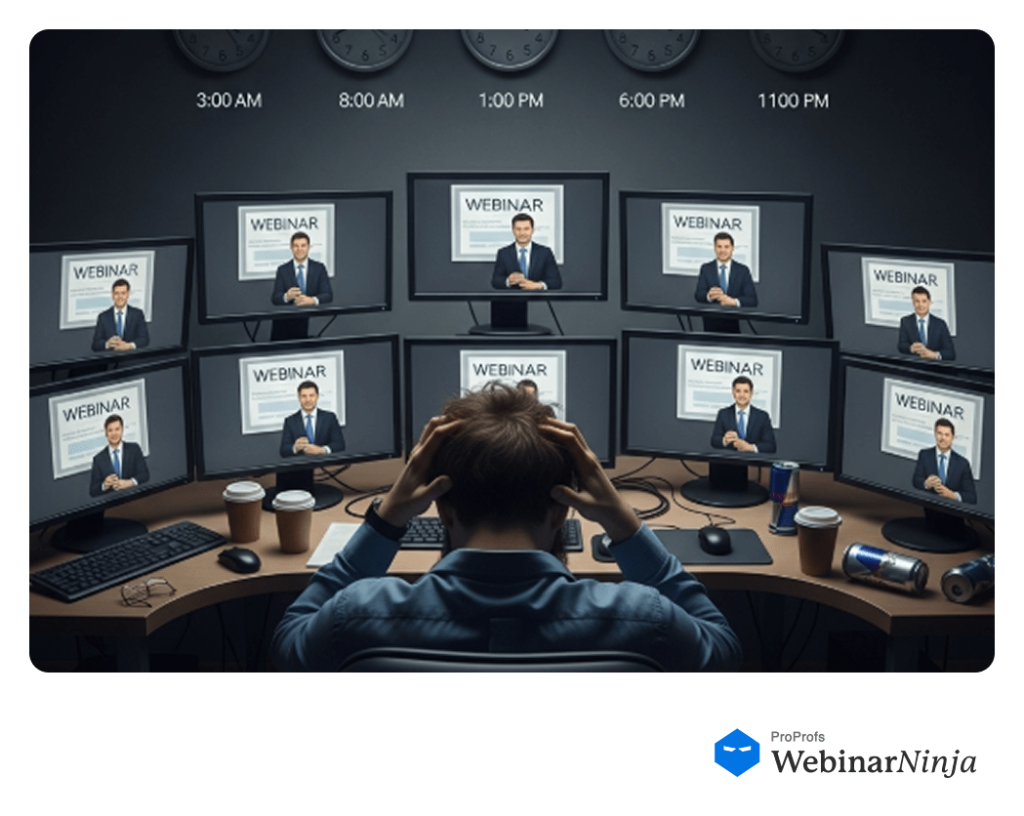
I once scheduled three simulive sessions a day across time zones, and by the end of the week, I was drained from sitting in chat waiting for questions. Some sessions had only a handful of attendees.
To solve this, I started using platforms that notify me when someone actually asks a question, so I don’t waste hours monitoring empty rooms.
Sounds good?
Now that we’ve examined the challenges, let’s discuss how to make simultaneous webinars truly successful.
Best Practices for Running Simulive Webinars
A simulive webinar is only as good as the thought you put into it. I’ve seen people treat it like a simple video upload and end up disappointed.
The truth is, when you design it like a real event, with strategy, care, and interactivity, it becomes one of the most powerful tools in your marketing or training toolkit.
1. Be Transparent to Build Trust & Credibility
Attendees can forgive a recorded presentation, but won’t forgive feeling tricked. Always be upfront that the presentation is recorded while highlighting the live support and interaction attendees will receive.
Example: A SaaS company promoting a new feature told registrants, “The demo is recorded for clarity, but our product team will be here live in chat to guide you and answer every question.” That simple framing reassured attendees, and participation in chat actually went up.
From my own experience, once I stopped worrying about “pretending it was live” and just owned the format, I noticed more engagement and fewer drop-offs.
2. Design Interactive Moments That Keep People Engaged Until the End
A simulive webinar without interaction feels like a YouTube replay. To keep people hooked, you need to plant moments where they’re asked to act deliberately.
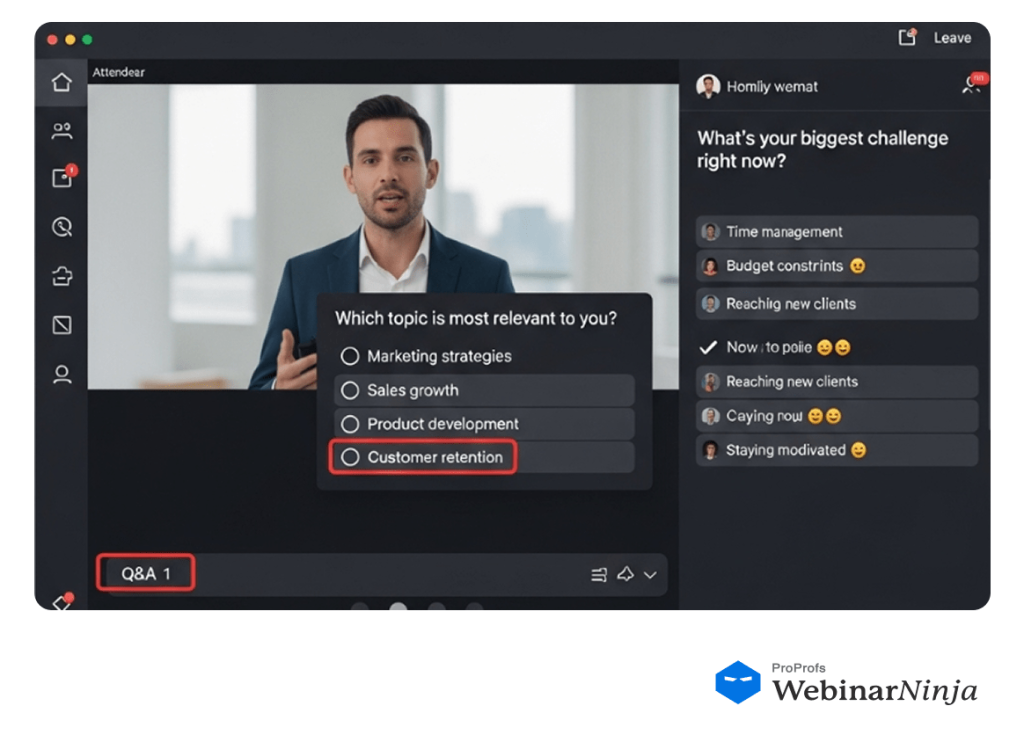
- Insert polls at natural breaks to spark curiosity.
- Seed the chat with questions like “What’s your biggest challenge right now?”
- Plan a dedicated Q&A window at the end.
Example: In one of my training sessions, I asked attendees mid-way, “Which of these challenges do you face most often — time, tools, or team?” The flood of responses kept energy high and carried people through the last 20 minutes.
3. Keep Your Content Evergreen to Extend Its Shelf Life
Think of your Simulive webinar as an investment. If you avoid time-sensitive references, you can use them repeatedly without them ever feeling stale.
Example: A digital marketing consultant recorded a webinar on SEO basics and carefully avoided lines like “This year’s trends” or specific dates. That recording ran as an evergreen webinar session for 18 months and kept generating leads.
Personally, I once made the mistake of saying “Happy New Year 2023!” in a video. By February, it already felt outdated, and I had to re-record. Lesson learned.
4. Test Every Single Element Before Launch to Avoid Embarrassing Failures
I cannot stress this enough: run a dry test before going live. A single webinar mistake, like a muted video or broken poll, can ruin the experience.
Example: An education startup once discovered its YouTube video was marked “Private” only during testing. If they hadn’t checked, hundreds of registrants would have seen a blank screen.
From my side, I always test the playback, email reminders, and polls at least 24 hours before launch. That habit has saved me from more last-minute disasters than I can count.
5. Deliver Value Beyond the Webinar to Strengthen Relationships
The most impactful webinars don’t end when the video stops. Attendees remember what happens afterward: the resources, the session follow-up, and the personal touch.
Example: A sales coach I worked with sent attendees a replay link, a PDF checklist, and answers to unanswered chat questions within 24 hours. Compared to generic “thank you” emails, their post-webinar conversions doubled.
When I adopted this approach myself, I noticed that attendees were far more likely to book calls because they felt cared for beyond the session.
6. Choose the Right Platform to Save Time & Maximize Engagement
Your platform choice can make or break the simulive experience. Look for one that supports recurring schedules, smart chat notifications, and integrations with your CRM or email tools.
Example: A small business first tried streaming pre-recorded webinars using basic video conferencing software. The result was clunky playback, disengaged attendees, and endless troubleshooting.
When they switched to a dedicated Simulive platform, they were able to schedule recurring sessions, automate registration, and improve the viewing experience, all while saving hours of setup time.
Now that we’ve covered best practices, let’s step back and look at how simulive webinars fit into the bigger picture.
Market Trends Around Simulive Webinars
Simulive webinars have gone from a niche strategy to a mainstream tool for businesses, educators, and creators. The way people are using them in 2025 reveals some clear shifts in how online events are being run.
1. Growing Adoption Across Industries
When I first experimented with Simulive, I saw only marketers using it. Now, I see it everywhere: universities, healthcare providers, SaaS companies, and even government agencies.
For example, one education platform runs evergreen webinar sessions for onboarding new learners worldwide. Instead of scheduling dozens of live sessions, they replay the same polished content while faculty staff answer questions live in chat.
2. Moving Away From “Fake Webinar” Tactics
A few years ago, some automated webinar tools promoted gimmicks like fake attendee lists or pre-written chats.
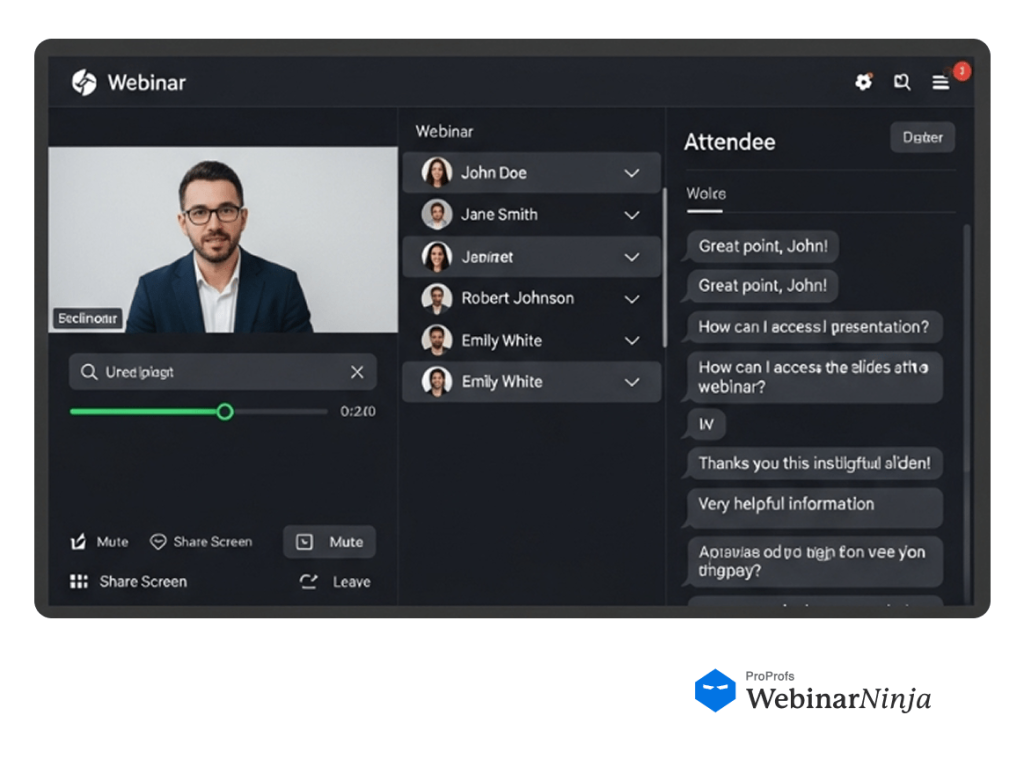
Today, that’s frowned upon.
Transparency has become the norm because audiences are savvy. A marketing agency I worked with saw registrations drop when people felt misled, but once they rebranded their simulive as “recorded presentation with live Q&A,” attendance and trust bounced back.
3. Demand for Integration & Automation
Modern hosts want more than just video playback; they want tools that easily integrate into their CRM, email campaigns, and analytics.
This shift is why many choose platforms like WebinarNinja, Demio, or Livestorm.
For instance, a small eCommerce brand now integrates Simulive webinars with their email marketing tool, automatically sending replays and personalized offers after each session.
4. Rise of Global & Multi-Timezone Events
The pandemic accelerated global participation in online events, and Simulive has become the go-to solution for reaching international audiences.
A tech startup I know runs the same Simulive webinar three times daily: once for Asia, once for Europe, and once for North America. Attendees feel like the event was designed for them, while the team only had to record once.
5. Community-Driven Learning & Adoption
People are no longer just reading vendor sites to decide; they’re going to Reddit, LinkedIn, and communities to ask, “What’s the best Simulive webinar software you’ve used?”
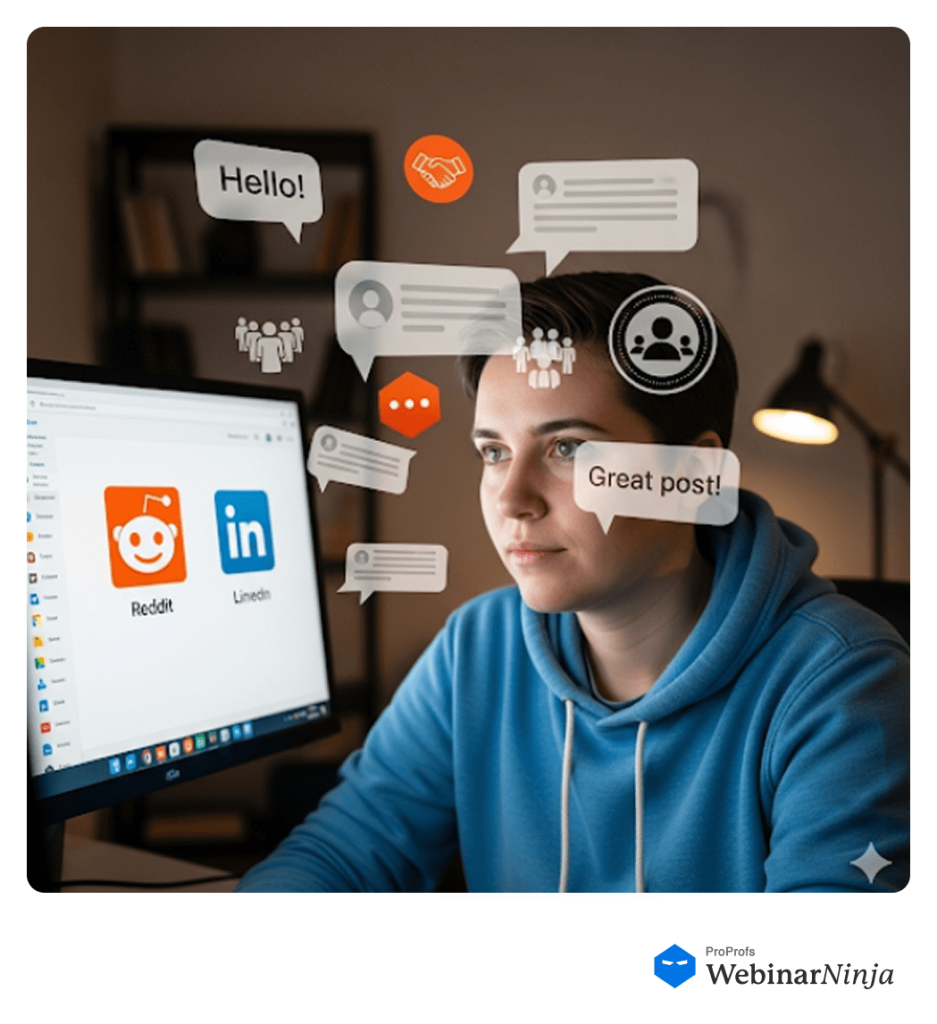
Peer recommendations and case studies are shaping adoption.
In my own case, I first heard about Simulive on a podcast where the host described how it freed up their sales team’s time. That story pushed me to try it.
Having said this, let’s wrap up the conversation.
Embrace Simulive Webinars to Deliver Seamless, Engaging Events
As we have learned above, Simulive webinars give you the best of both worlds: the confidence of a polished, pre-recorded presentation and the energy of live interaction. They save time, reduce stress, and let you scale your reach without sacrificing audience engagement.
From my experience, the biggest win is how Simulive frees you to focus entirely on your audience. Instead of worrying about forgetting lines or fixing slides on the fly, you can dedicate yourself to answering questions, starting conversations, and building trust.
But here’s the truth: the success of a simulive webinar depends heavily on having a dedicated webinar platform. When I tried cobbling together generic video tools, the result was clunky and unprofessional. Switching to a platform built for Simulive completely transformed the experience, with smoother playback, automated scheduling, and more engaged attendees.
So let me ask you: Will you try a simulive webinar for your next event?
Frequently Asked Questions
What Types of Content Work Best for Simulive Webinars?
Simulive works best when the content is repeatable, consistent, and doesn’t rely heavily on improvisation. Product demos, compliance training, HR onboarding, and thought leadership presentations are ideal because they benefit from polish and clarity. On the other hand, coaching calls or highly interactive workshops that thrive on spontaneity are better suited for fully live or hybrid formats.
Do Simulive Webinars Offer Replays Automatically?
Most webinar platforms, like WebinarNinja, that support Simulive also let you provide replays once the scheduled session ends. This means attendees who couldn’t join live can still watch on demand, while those who attended get a follow-up resource. Some platforms even allow you to set up recurring or evergreen replays so your content keeps working for you long after the first event.
Can Simulive Webinars Handle Multiple Languages or Global Audiences?
Absolutely. Because the main presentation is pre-recorded, you can add subtitles, translations, or captions to reach multilingual audiences. You can also schedule the same webinar at different times for different time zones. I’ve seen companies run three sessions of the same webinar in one day: one for Asia-Pacific, one for Europe, and one for North America, without adding to the presenter’s workload.
What Are the Best Simulive Webinar Software & Tools?
The choice of platform depends on your goals, but I have had the best experience with WebinarNinja. Other trusted names in this space are Demio, EverWebinar, Livestorm, and WebinarGeek. These platforms are designed to make simulive seamless, offering features like pre-recorded video playback at scheduled times, live chat, polls, Q&A, and integrations with CRMs. The key is to test the workflow on whichever platform you choose so you’re confident the attendee experience will be smooth and engaging.
Want to host a webinar for free?
Use WebinarNinja to teach, improve marketing, and grow your sales.




![How to Host Paid Webinars [A Practical Guide + 6 Best Tools]](https://webinarninja.com/blog/wp-content/uploads/2020/05/Feature_WN_How-to-Host-Paid-Webinars-A-Practical-Guide-5-Best-Tools.png)

